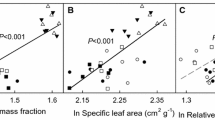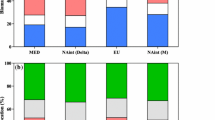Abstract
The effects of biological invasions are most evident in isolated oceanic islands such as the Hawaiian Archipelago, where invasive plant species are rapidly changing the composition and function of plant communities. In this study, we compared the specific leaf area (SLA), leaf tissue construction cost (CC), leaf nutrient concentration, and net CO2 assimilation (A) of 83 populations of 34 native and 30 invasive species spanning elevation and substrate age gradients on Mauna Loa volcano in the island of Hawaii. In this complex environmental matrix, where annual precipitation is higher than 1500 mm, we predicted that invasive species, as a group, will have leaf traits, such as higher SLA and A and lower leaf CC, which may result in more efficient capture of limiting resources (use more resources at a lower carbon cost) than native species. Overall, invasive species had higher SLA and A, and lower CC than native species, consistent with our prediction. SLA and foliar N and P were 22.5%, 30.5%, and 37.5% higher, respectively, in invasive species compared to native ones. Light-saturated photosynthesis was higher for invasive species (9.59 μmol m−2 s−1) than for native species (7.31 μmol m−2 s−1), and the difference was larger when A was expressed on a mass basis. Leaf construction costs, on the other hand, were lower for the invasive species (1.33 equivalents of glucose g−1) than for native species (1.37). This difference was larger when CC was expressed on an area basis. The trends in the above traits were maintained when groups of ecologically equivalent native and invasive species (i.e., sharing similar life history traits and growing in the same habitat) were compared. Foliar N and P were significantly higher in invasive species across all growth forms. Higher N may partially explain the higher A of invasive species. Despite relatively high N, the photosynthetic nitrogen use efficiency of invasive species was 15% higher than that of native species. These results suggest that invasive species may not only use resources more efficiently than native species, but may potentially demonstrate higher growth rates, consistent with their rapid spread in isolated oceanic islands.
Similar content being viewed by others
Author information
Authors and Affiliations
Additional information
Received: 26 February 1999 / Accepted: 23 June 1999
Rights and permissions
About this article
Cite this article
Baruch, Z., Goldstein, G. Leaf construction cost, nutrient concentration, and net CO2 assimilation of native and invasive species in Hawaii. Oecologia 121, 183–192 (1999). https://doi.org/10.1007/s004420050920
Issue Date:
DOI: https://doi.org/10.1007/s004420050920




